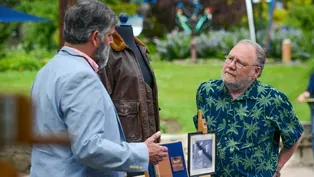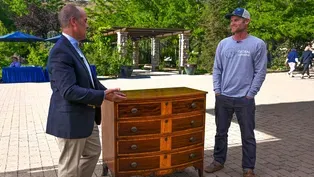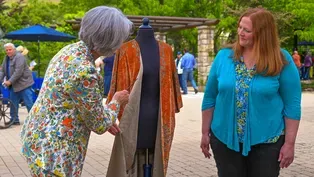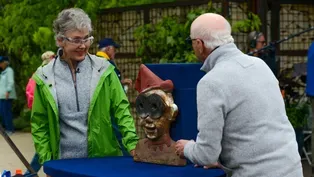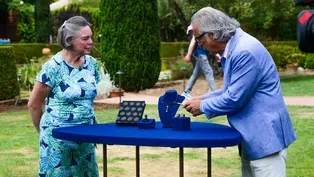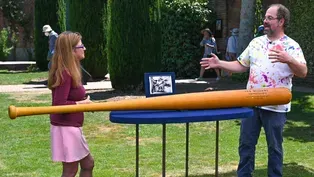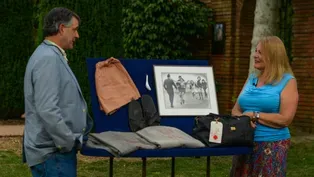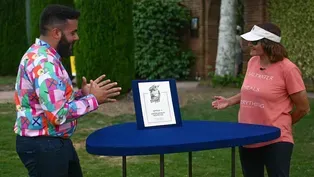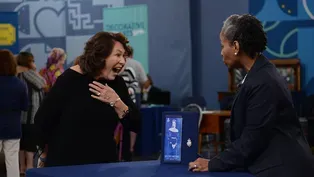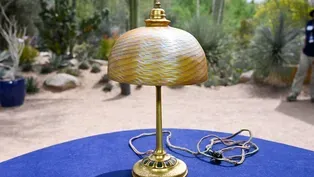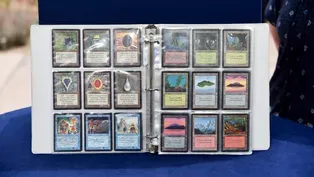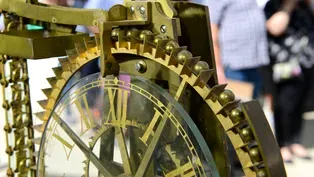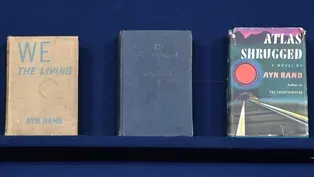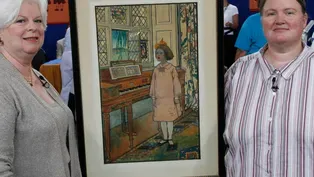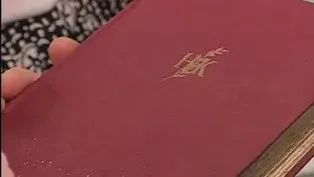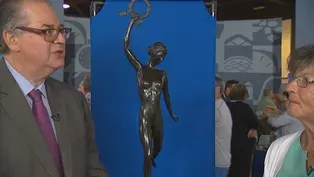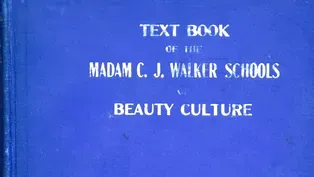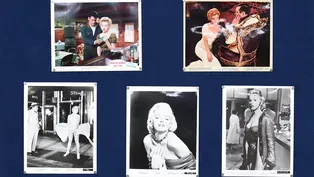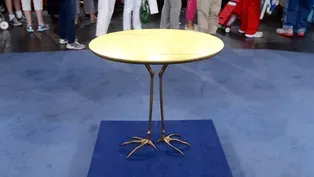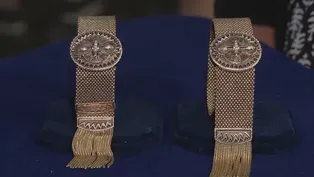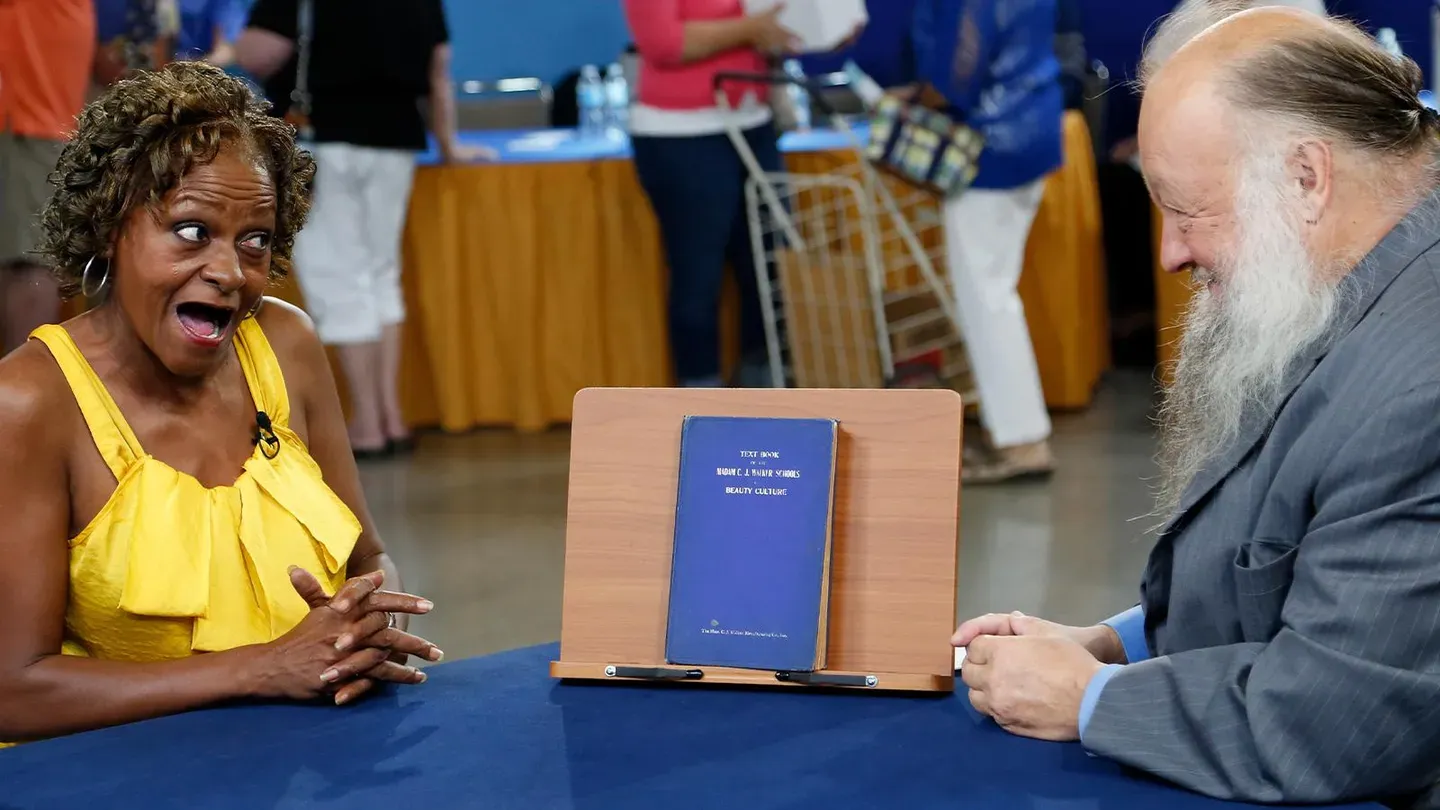

RECUT: Women's Work, Part 2
Special | 22m 28sVideo has Closed Captions
ROADSHOW continues to spotlight lasting contributions from outstanding women!
ROADSHOW continues to spotlight lasting contributions from outstanding women in Part Two of this RECUT special! Standout finds include a Madam C.J. Walker beauty book, Jackie Cochran-signed photos and WASP Wings, and a Maria Koogle needlework.
Problems with Closed Captions? Closed Captioning Feedback
Problems with Closed Captions? Closed Captioning Feedback
Funding for ANTIQUES ROADSHOW is provided by Ancestry and American Cruise Lines. Additional funding is provided by public television viewers.

RECUT: Women's Work, Part 2
Special | 22m 28sVideo has Closed Captions
ROADSHOW continues to spotlight lasting contributions from outstanding women in Part Two of this RECUT special! Standout finds include a Madam C.J. Walker beauty book, Jackie Cochran-signed photos and WASP Wings, and a Maria Koogle needlework.
Problems with Closed Captions? Closed Captioning Feedback
How to Watch Antiques Roadshow
Antiques Roadshow is available to stream on pbs.org and the free PBS App, available on iPhone, Apple TV, Android TV, Android smartphones, Amazon Fire TV, Amazon Fire Tablet, Roku, Samsung Smart TV, and Vizio.
Buy Now
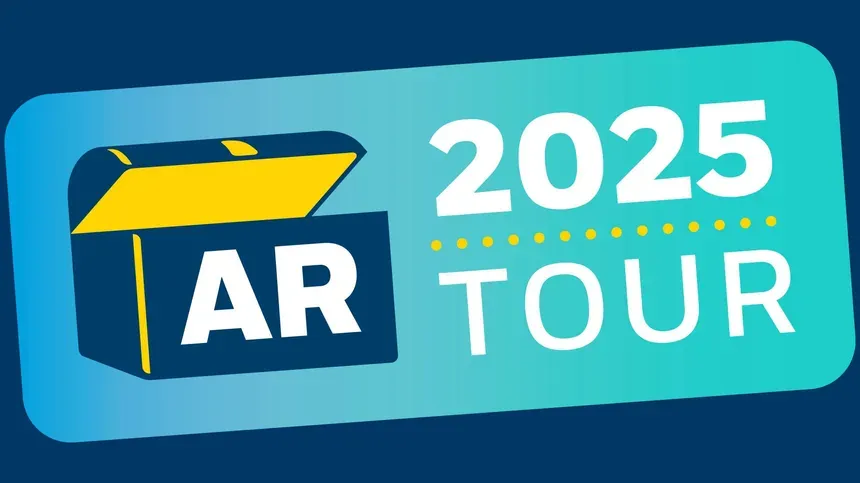
ANTIQUES ROADSHOW 2025 Tour!
Enter now for a chance to win free tickets to ANTIQUES ROADSHOW's 2025 Tour! Plus, see which cities we're headed to!Providing Support for PBS.org
Learn Moreabout PBS online sponsorshipMore from This Collection
RECUT: Idaho Botanical Garden, Part 4
Video has Closed Captions
Wrap up Season 4 of RECUT with a $50,000 appraisal at Idaho Botanical Garden! (22m 31s)
RECUT: Idaho Botanical Garden, Part 3
Video has Closed Captions
Visit the “City of Trees” for unbe-leaf-able Boise treasures in this half-hour RECUT. (22m 31s)
RECUT: Idaho Botanical Garden, Part 2
Video has Closed Captions
In this half-hour RECUT, watch breathtaking Boise appraisals at Idaho Botanical Garden. (22m 31s)
RECUT: Idaho Botanical Garden, Part 1
Video has Closed Captions
Gem State treasures sparkle in this half-hour RECUT at Idaho Botanical Garden! (22m 31s)
Video has Closed Captions
Watch wow-worthy Woodside finds in this half-hour RECUT and learn which is up to $44,000! (22m 24s)
Video has Closed Captions
In this half-hour RECUT episode, golden state treasures shine at Filoli. One is $150,000! (22m 23s)
Video has Closed Captions
Watch fascinating Filoli finds in this half-hour RECUT, including one up to $100,000! (22m 36s)
Video has Closed Captions
This season's first half-hour of RECUT wows our guests with a $200,000 to $330,000 find! (22m 30s)
RECUT: American Stories, Part 1
Video has Closed Captions
Learn the stories of objects that represent American traditions and triumphs! (22m 28s)
RECUT: Desert Botanical Garden, Part 2
Video has Closed Captions
Phoenix treasures heat up, like one appraisal up to $35,000, in this half-hour RECUT! (22m 28s)
RECUT: Desert Botanical Garden, Part 1
Video has Closed Captions
Phenomenal Phoenix finds abound in this half-hour RECUT. One is worth up to $100,000! (22m 26s)
RECUT: Crocker Art Museum, Part 2
Video has Closed Captions
See stunning Sacramento finds like one $80,000-$125,000 treasure, in this half-hour RECUT! (22m 28s)
Providing Support for PBS.org
Learn Moreabout PBS online sponsorship♪ ♪ CORAL PEÑA: "Antiques Roadshow Recut" is spotlighting women who made and inspired lasting treasures.
It was done by my great-great-grandmother.
PEÑA: Stay tuned for part two of "Antiques Roadshow Recut: Women's Work."
♪ ♪ This was designed by Méret Oppenheim, one of the female Surrealists.
In a movement that was dominated by male figures, she brought a distinct feminine appeal to the movement.
PEÑA: In this episode of "Antiques Roadshow Recut," we're saluting women who made their mark in history.
Scudder was one of the leading artists of the early 20th century.
PEÑA: Starting off with a trailblazing self-made millionaire.
Take a look.
I don't really know a whole lot about the book.
I believe it's the first African American beauty book.
How did you acquire the book?
A friend of mine-- I'm a hairdresser.
Uh-huh.
And he give me the book.
He thought I might enjoy it.
The cover title says it's the "Text Book of Madam C.J.
Walker"... Uh-huh.
..."Schools of Beauty Culture."
Yeah.
So, at first blush, it just seems to be a textbook.
And in the antiquarian book trade, we don't think a whole lot of most textbooks.
Uh-huh.
But you really caught my attention when you said that this was a early hair products and hair care and styling book for African American women.
Did you learn anything from the book?
There are some home remedies I've tried out of the book.
And then some of the product in the book you can no longer get.
Well, the book's around 100 years old, so... (laughing): Really.
Not surprising.
Yeah.
Let's open the book up here.
Okay.
To the title page.
Okay.
There we have the "Madam C.J.
Walker Beauty Manual."
First edition.
And it, indeed, is... the very first book published for hair styling and fashion for African American women.
There's one more page I'd like to turn to that shows some of the hair care products.
Quite a big, healthy line of different products.
Yes, it was very fascinating to me, looking at it, and looking at the prices back then.
(laughs) Pretty nostalgic.
Yes, yes.
You said that some of the methods and products involved in the book are still valid today?
Some are, and some are not.
Okay.
You would know far more about that than I.
Yes, I am a licensed beautician.
Madam Walker was actually Sarah Breedlove.
She was born on a Louisiana plantation in 1867.
Really?
Her family were a slave family on a plantation.
Uh-huh.
And she was the first child in her family born into freedom after the Emancipation Proclamation.
I didn't know that.
And the company that bears her name is still in business to this day, making hair and facial products for African American women.
Really?
She also, according to the "Guinness Book of World Records," is the first American self-made millionaire female.
Are you serious?
I didn't know that, either.
(laughs): I had no clue.
Pretty fascinating.
Yeah.
Do you have an idea of what the book's worth?
I'm not for sure what it's worth.
Maybe $3,000?
The book's in very good condition.
Okay.
It's not a fine-condition copy.
Right.
But in today's market, with the interest in early and important African American material... Uh-huh.
The first edition of this book is scarce enough that at retail, this book would sell for $10,000-plus.
(laughing): $10,000!
Are you serious?
I am serious.
Oh, you're kidding!
No, I'm not.
$10,000?
Yes, ma'am.
Oh.
(laughing) I don't believe it.
Thank you.
WOMAN: It's a picture that belonged to my great-aunt, and she was supposedly the subject in the painting.
She lived in Pittsburgh when she was growing up, and her family was a friend of the artist's family.
The artist being?
Elizabeth Shippen Green.
And the picture has been in my aunt's possession until she passed away.
It went to my father.
And then about 11 years ago, he gave it to me.
Elizabeth Shippen Green is quite an important American illustrator.
She goes back to what we call the Golden Age of Illustration in America.
She was a Philadelphian.
Mm-hmm.
And she came from an artistic family.
Her father was an artist, and she studied first at the Pennsylvania Academy under Thomas Eakins.
She subsequently studied at Drexel with Howard Pyle, who's one of the great American illustrators.
When she was in Pyle's studio, she met two other women named Violet Oakley and Jessie Willcox Smith.
Right.
And the three of them formed this triumvirate of the most important female American illustrators.
She was the only woman who was under contract to "Harper's Weekly."
Oh, cool.
And she was under contract exclusively to them from around 1900 to about 1920.
And with Violet Oakley and Jessie Willcox Smith, she took a communal studio, a living space in Villanova that was called the Red Rose House, or the Red Rose Inn.
Oh, okay, right.
Red Rose Girls.
And the three of them became known as the "Red Rose Girls."
This is a particularly charming picture, and typical of the subjects that she did in the very early part of the 20th century...
Right.
...when she was focusing on illustrations of children.
And it's typical of her technique.
She would work in charcoal first.
Okay.
And apply some sort of fixative over the charcoal drawing.
Oh.
And then work in these glazes over the top with watercolor and gouache.
(murmurs) And she would get these very jewel-like tones of color.
She was also known for incorporating outdoor landscape scenes.
There's a little tiny example of that here with the window.
Mm-hmm.
Her work has come up at auction, but not frequently.
There are about a dozen examples that I've been able to find, and only two or three that are very comparable to, to this particular picture.
Okay.
I'd say an auction estimate, conservatively, based on some of those prices, would be between $20,000 and $30,000.
Oh, wow.
That's nice.
APPRAISER: Toshiko was one of the postwar contemporary artists working in clay.
She invented these, this form.
"Moon pots," they're called-- a pinched top.
She put, usually, a little stone or a pebble that would... (pot rattling) ...create a rattling sound.
(murmurs) At auction, these tea bowls are worth about $200 to $250 apiece, but a moon pot like this would sell for between $1,500 and $2,000.
APPRAISER: There's a lot of interest in African American folk artists from the South.
And as this is a, kind of a quintessential piece by Minnie Evans, an auction estimate for something of this size would be $2,000 to $4,000.
Wow.
Thank you.
WOMAN: I had a neighbor who worked for a company that produced movie posters.
He was 92 at the time that he died, and he had no children.
His sister-in-law knew that I was his buddy, and asked me if there was anything of Frank's that I would like.
These were in his attic, and I thought they were kind of cool.
Well, I think they're really cool.
I mean, apart from the obvious-- they're all of Marilyn Monroe, which is why I got excited when I saw them-- they're film stills, and the ones that you find in shops today, they're reprinted and reprinted and reprinted, and so they're so far from the originals.
And every one that you have here is a pristine, crisp, clean, shiny original.
We have five different things represented here.
We have a set from "The Prince and the Showgirl," which is complete-- they came in sets of 12, and the rest of them are down here in that stack.
We have nine of the 12 "Bus Stop" images.
Then we have, on this stack, what Fox Studios put out at the time, which was kind of what I call "the omnibus."
It was her greatest hits.
It was all of the most wonderful movies Marilyn's done for Fox, and they were trying to publicize her, and so they sent out this stack of 20.
The stack in the center are the "glamour shots," or I call them.
They came as a set of ten, and you have the complete ten.
And the far side is a complete set of 20 black-and-white film stills from the movie "Bus Stop."
How long ago was it that you acquired these from the attic?
About 15 years ago.
So for 15 years, you've...
I've been curious.
(laughs) It's not been until probably the past ten years that collectors have really started to value these original vintage prints.
And they're doing quite well at auction.
So if I were you, I would insure them for between $18,000 and $20,000.
(laughs) I-- thanks, Frank.
(both laugh) Frank's smiling somewhere, I'm sure.
I'm sure-- I am.
(both laugh) And they're just stunning-- they're pristine.
This table belonged to my uncle, who was an architect.
I have a number of his papers, so I saw that this table he purchased at Palazzetti in New York.
But I didn't see any bill.
He had a really whimsical sense of humor, so this piece fit right in.
He died about six or seven years ago.
And I inherited his furniture.
And I sold some things, but this one I loved, and I said, "I'm, I'm keeping this one."
Well, it's interesting that you used the words "whimsical" and that he had a sense of humor, because one of the things that I love about this table is that both of those things are infused into the design.
So, it's not really all about materials.
It's also about imagination and humorous ideas.
And those are hallmarks of the Surrealist movement.
Yes.
And this was designed by Méret Oppenheim, one of the female Surrealists.
In a movement that was dominated by male figures, she brought a distinct feminine appeal to the movement.
And this is not only tall and elegant, but it's also humorous, in that this wonderful sort of oversized, almost "Jurassic Park"-like bird leg is impressed on the top of the table.
If you could imagine a bird walking across a soft stream bed, and the impressions that the bird's feet would make, and she's covered it in gold leaf.
I think this is kind of the epitome of the Surrealist movement.
It was designed in 1939, at the height of the Surrealist movement.
But it wasn't put into serial production until the early '70s.
And there was a company called Simon Gavina that acquired the rights to produce this.
And, in fact, technically, they reproduced it.
So what you have here is a reproduction.
You tend to hear that word and you think it can't be very valuable because it's a reproduction.
Have you ever had any idea what it might be worth?
I saw it went on auction three times.
The lowest was $2,500.
I saw it, I think it was 2007, and it went for over $13,000.
And then more recently, it was about $7,000, so it could be anywhere there, but I'm not selling it.
The market actually wants items that were produced closer to the original reproduction date.
They were originally produced in 1971.
And in fact, you can still buy them today.
You can buy one for under $3,000 that's still an authorized reproduction.
Now, one thing your table does not have is a label.
Uh-huh.
The labels changed over the years, and you can tell a little bit more about the production from the label.
The one that you saw that sold for $13,000 actually had one of the original labels from the early '70s, and that gives buyers a confidence about when it was produced.
When it was done.
I think he purchased it in 1979.
So, that puts it in the early period.
One of the ways that I can tell that it was a '70s production is by looking at these screws underneath.
This is exactly how they were produced in the '70s, and it's slightly different today.
In this condition, as an example from the 1970s, I would say that at auction, this table would probably bring about $7,000.
That's excellent news, excellent.
And I really, I love it.
WOMAN: We have three Ayn Rand books.
My great-grandmother Sarah was Ayn Rand's first cousin.
APPRAISER: Wow.
And Sarah was Ayn's sponsor to the United States in the 1920s.
Ayn was very intelligent, Uh-huh.
And was able to exit Russia to study film in America.
Mm-hmm.
And Sarah's husband at the time was an owner of movie theaters.
So the Russian government allowed her to have a visa to come and study film.
To Chicago?
Correct.
Right, well, they're terrific examples.
We have her first published book in the United States, "We the Living," and "The Fountainhead," and "Atlas Shrugged."
And of course, what's wonderful about them is that they're all inscribed.
Rand did not like to sign books frequently.
And so, it's lovely to have these inscriptions that were not only written to someone in particular, but a family member who was instrumental to bringing her to the United States.
It's what we call an association copy.
So, in this particular case, she says, "With profound gratitude for saving me from the kind of hell described in this book."
"We the Living," she had a lot of difficulty finding a publisher.
Nobody really wanted to publish the book, being sort of against Soviet communism, and Macmillan agreed to publish it, and at 3,000 copies, it eventually went out of print.
The book was released on April 7, 1936.
This inscription is dated April 2.
So, a full five days before it actually went out to publishers.
So it's what you would kind of call a pre-publication association copy.
So obviously, she must have kept in touch with the family.
This was inscribed November 30, 1943.
This is the fifth printing of the book.
Right.
And then, of course, back to the tour de force, "Atlas Shrugged," also inscribed, on November 6, 1957, about three weeks after the book was published.
There's always a premium to a book with an association to somebody important to the author.
The names are different, but you mentioned to me that your great-grandmother remarried, is that right?
(laughs) Four husbands, yes.
Four husbands, right.
These two are first editions, this is a fifth printing.
These two books, with just a general association, might have a auction estimate somewhere in the range of $4,000 to $6,000, $5,000 to $7,000.
This one, since it's a later printing, would be more to $2,000 to $3,000.
But because there are associations with the family, and they were so important in regard to the events in her life and bringing her out of Russia, I would describe the whole group at auction to have a global estimate of $20,000 to $30,000.
(chuckles) Thank you so much for bringing it in.
Thank you-- thank you.
WOMAN: The sculpture was originally obtained by my great-uncle.
He collected a lot of different pieces, and this happens to be one of them.
APPRAISER: So when you came in, I was very excited to see this.
And I was very disappointed in that it wasn't signed.
And while we were talking, and I had my super flashlight, we turned it around, and you were just at eye level with the back of this wreath...
Right.
And the artist's initials are there.
There they are, yeah.
And her name is Janet Scudder.
She was an American artist.
Right.
She was born in the 19th century.
The sculpture's from about 1915.
Okay.
It's called "Victory," and the condition is wonderful.
Scudder was one of the leading artists of the early 20th century.
She was very active as a suffragette.
She was against having separate exhibitions of women art.
So she was really quite a dynamic individual.
I would put a retail value of this between $15,000 and $20,000.
Oh, wow-- oh, that's exciting.
That's fantastic.
WOMAN: I inherited this needlework from my mother.
It was actually done by my great-great-grandmother, who was from Ohio.
And we know that she was born in 1803.
Correct.
And the family history says that she was about 14 years old when she made this.
Yes.
So we're dating this to 1817.
1817.
And it is a schoolgirl needlework.
And it really has an extraordinary composition.
And this one has some very, very special features.
It's silk thread on a silk background.
Mm-hmm.
Looking at the piece, we see tremendous affluence, and it may not be too hard to believe that she possibly attended school on the East Coast.
Mm-hmm.
But more research needs to be done about that.
Each of the women are wearing a different costume.
And they're displaying the styles of the day... Mm-hmm.
...that were worn between 1800 and, let's say, 1825.
The color of this is so extraordinary.
The blues are totally rich, the sky.
And typically, what we have found with pieces such as this, that the scene in the background of the town...
Yes.
...and the faces might have been done in a gouache watercolor by the teacher.
Mm-hmm.
Now, have you ever had the piece appraised?
After my mother passed away, somebody who came to the house who was an antique dealer in Phoenix did offer me, first, $3,000, and later, when she came back, she offered me $6,000 for it.
Okay.
I would put a market value on this piece of around $40,000 to $50,000.
Oh, my.
(laughs) Now, for insurance purposes, would... For insurance purposes, I would go $50,000 to $70,000.
Oh, my, okay.
WOMAN: I brought some World War II memorabilia from the WASPs, the Women's Air Service Patrol.
This is Jackie Cochran.
She headed up the WASPs in World War II.
And my mother was her secretary.
And my mother asked Jackie Cochran if she could have a set of the wings, and Jackie said yes.
And so, that's what you see over here, is her wings.
And she had it engraved to my mom on the back.
And tell me about your photographs.
The photographs were autographed by Jackie Cochran to my mom.
This one was, "For Miss McSweeney, with all good wishes, Jacqueline Cochran."
And then, this one over here to the right I think is funny.
Um, "To Miss McSweeney, "This is just the way I feel sometimes.
Jackie Cochran."
And then my mom put a little notation underneath that, "Most times."
(laughs) So did your mom tell you anything about why she made that notation?
It didn't matter what time of day it was, if Jackie called, you, you came.
She was a demanding woman, but she was also, it seemed like she was really a nice person, as well.
Well, she was also a force of nature.
She was somebody who was a very, very accomplished aviator before the war.
She won a number of the air trophies.
She worked with Amelia Earhart.
She had connections before the war even started, and we see the WASPs during World War II, but the genesis of that started in 1939, when Jackie wrote to Eleanor Roosevelt and said, "You know, I think there should be a role for women within the..." Oh, nice.
At that time, it was the Army Air Corps.
And that kind of got passed up the chain, and in 1941, prior to our involvement in the war, she was even corresponding with officers in the Army Air Corps, talking about, women could ferry aircraft.
There were jobs that they could take over and let the men go and do something else.
So, when she comes back to the United States, as that first class comes through... Yeah.
..they're training with Jackie in command-- she wanted wings for these ladies.
And she simply paid for them out of pocket.
I do remember reading that now, yes.
So, even though your mom was not a pilot, these were Jackie's to give out.
Right.
And clearly, she decided that's what she... That's what she needed to do.
And she has engraved this on the reverse, specifically to your mother.
Yes.
Which is awesome.
Yeah, I think so.
Clearly, you understand the historical value.
Yes.
Because you understand how it relates to women's position within flying, and now we've got...
Some of the best pilots in the Air Force are female, which is awesome.
Mm-hmm.
So they've, they've come a long way, but she is really the driving force that got that all started.
Have you given any thought to, beyond the historical value, what the monetary value might be?
Not whatsoever-- have no idea.
A retail value on the market today for this set would be, conservatively, between $6,000 and $8,000.
Are you kidding me?
(chuckling): Oh, my gosh.
Great, well, thank you very much.
I really appreciate it.
It's crazy.
♪ ♪ PEÑA: Thanks for watching.
We hope you've enjoyed this episode of "Antiques Roadshow Recut."
Appraisal: Ayn Rand Inscribed Books
Video has Closed Captions
Clip: Special | 2m 49s | Appraisal: Ayn Rand Inscribed Books (2m 49s)
Appraisal: Elizabeth Shippen Green Illustration, ca. 1907
Video has Closed Captions
Clip: Special | 2m 28s | Appraisal: Elizabeth Shippen Green Illustration, ca. 1907 (2m 28s)
Appraisal: First-edition Signed Helen Keller Journal
Video has Closed Captions
Clip: Special | 36s | Appraisal: First-edition Signed Helen Keller Journal (36s)
Appraisal: Janet Scudder "Victory" Bronze, ca. 1915
Video has Closed Captions
Clip: Special | 1m 8s | Appraisal: Janet Scudder "Victory" Bronze, ca. 1915 (1m 8s)
Appraisal: Madam C.J. Walker Beauty Book, ca. 1928
Video has Closed Captions
Clip: Special | 3m 30s | Appraisal: Madam C.J. Walker Beauty Book, ca. 1928 (3m 30s)
Appraisal: Marilyn Monroe Publicity & Film Stills
Video has Closed Captions
Clip: Special | 2m 2s | Appraisal: Marilyn Monroe Publicity & Film Stills (2m 2s)
Appraisal: Meret Oppenheim "Traccia" Table, ca. 1979
Video has Closed Captions
Clip: Special | 3m 28s | Appraisal: Meret Oppenheim "Traccia" Table, ca. 1979 (3m 28s)
Appraisal: Victorian Gold Garter Bracelets, ca. 1870
Video has Closed Captions
Clip: Special | 30s | Appraisal: Victorian Gold Garter Bracelets, ca. 1870 (30s)
Providing Support for PBS.org
Learn Moreabout PBS online sponsorshipSupport for PBS provided by:
Funding for ANTIQUES ROADSHOW is provided by Ancestry and American Cruise Lines. Additional funding is provided by public television viewers.


